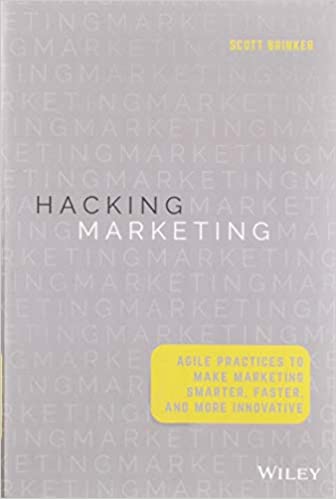It is not by chance that Scott Brinker called his book “Hacking marketing”. As a rule, people associate the word “hacking” with a negative, even criminal context, because the media has imposed this idea on them. But if you look closely at this concept, you can see that “hacking” has a different meaning, a positive one. Among software developers, this means the art of invention, that is, the creation of something new. That’s why the author chose this word.
According to him, hacker or agile marketing is about bringing a little inventive hacker spirit into the management and practice of marketing. Why did Scott Brinker decide to use a word from a computer environment? The answer is quite simple. Throughout his book Hacking Marketing: Agile Practices to Make Marketing Smarter, Faster, and More Innovative, he draws a parallel between marketing and the field of software development. At present marketing includes both digital tools (websites, email, online advertising, search engine marketing, and social networks) and non-digital (traditional TV, print, radio, and out-of-home advertising, trade show events, in-store marketing, public relations, brand management, channel management, Market research, pricing). But do not divide them into two separate categories, this division is quite conditional.
All these tools are interconnected and intersect. For example, participation in exhibitions. Exhibitions can be held in two formats, in person or online. But in any case, you will use digital technologies. Even if you prefer to participate in person, you need to sign up, and for this, you will visit the organizer’s website, fill out the form, after which you will receive a confirmation letter or an entrance ticket to your email address. Digital technologies are closely integrated into our lives, both in everyday life and in work, so it is worth taking this as a fact and trying to get the maximum benefit. To do this, the author recommends learning from IT developers, since they were the first to encounter the digital world and are more familiar with it than others. Many software development techniques are also applied to agile marketing.
At the beginning of the way, creating software took a lot of time, but developers had to speed up with new technologies, so such a methodology as agile software development became popular. It broke the process of creating a product into a number of short cycles. The software has become less focused on the release of the final product and more on an ever-evolving set of features. Marketing has also faced such a problem since its activities also rely on long planning cycles, which has become insufficient in the modern world. Therefore, there was also a need for acceleration.
Currently, marketing has become more focused on the customer, and not on their own plans, since it is the consumer who now dictates their own rules. They can, for example, use reviews in social networks to instantly respond to certain steps of the company, so it is very important to listen to your customers. And this can’t be done if you have a long-term plan, and you can’t move away from it, you need to be more mobile and more agile.
Scott Brinker highlights in his book four main aspects of modern marketing management – agility, innovation, scalability, and talent. But he warns that the described ideas must be adapted to your company individually since there is no golden rule for success because what works for some will not necessarily work for you.
So, let’s start with AGILITY. Most of the book is devoted to this aspect.
Scott Brinker considers three main methodologies of agile management – Scrum, Kanban и Scrumban.
Scrum
The name was taken from the vocabulary of the game of rugby, which means a method of playing in which players tightly gather together, with their heads down, and try to take possession of the ball. The Scrum agile methodology was developed by Ken Schwaber and Jeff Sutherland. The methodology suggests dividing the process into a series of sprints. Sprints are the execution of items from a prioritized task list. The average sprint length is two weeks, but the deadline may vary, the main thing is that it should not be more than a month.
For agile marketing purposes, a sprint can have the following cycle: Update Backlog, Sprint Planning, Sprint Review-Team Retrospective.
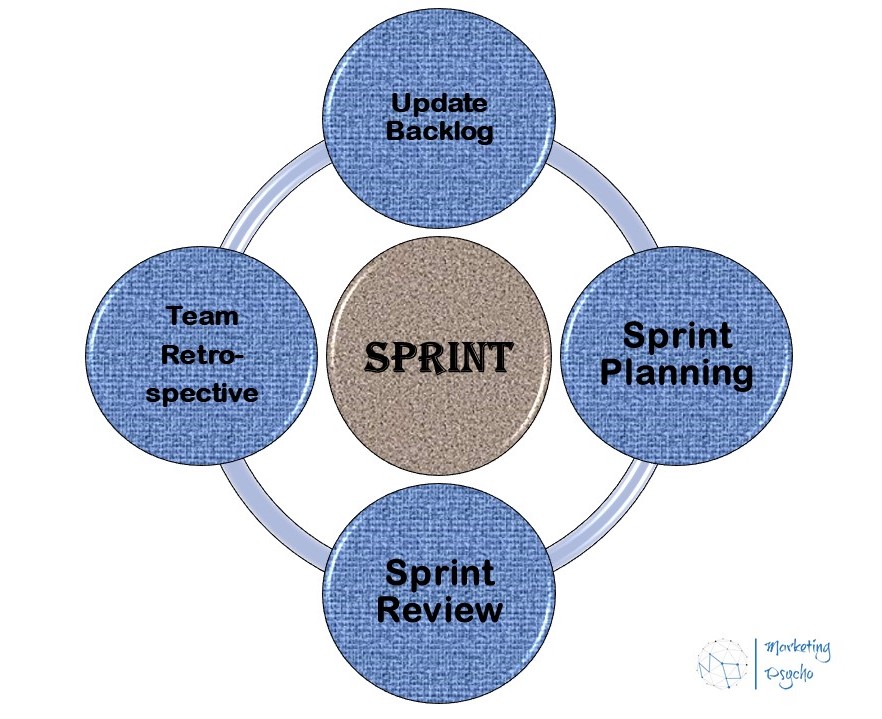
A big project or campaign will rarely be completed in one sprint, so they are divided into a number of smaller sprints, and programs such as content marketing can be organized as a continuous stream of sprints covering the entire duration of the program.
Backlog is the usual state of sprints since the execution of a sprint is a live process, within which a large number of new ideas appear, but since the sprint is limited in time, not all of them can be implemented, so they are postponed and waiting for their time. New tasks may also appear in connection with the identification of new circumstances, so a number of current tasks also have to be postponed to deal with more urgent ones, or, conversely, if new tasks can wait, then they are put off. It is incredibly important that the tasks in the Backlog are prioritized, ranked in the order in which they should be completed. What makes this agile is that the backlog can be changed at any time. New tasks can be added, existing tasks can be changed or deleted, and their relative priority can be changed. However, at the beginning of a new sprint, the backlog should be updated according to the current priorities before the sprint planning begins.
Sprint Planning is a meeting of all team members to study the most priority tasks in the backlog, evaluate the required work, and make a commitment to fulfill them in this sprint. This is not a very long meeting, a maximum of two hours during each week in the sprint. Tasks are not imposed on the team, the manager can control what is in the backlog, in what priority, but the team independently decides what it will achieve in the sprint.
After planning, the sprint implementation begins directly. At this time, the team is going to the daily stand-up. These are short, usually 15-minute meetings that are best held in the same place and at the same time to avoid wasting time on coordination. The name stand-up is because meetings are usually held standing up to emphasize its short duration, but this meeting also has another name – the daily scrum.
During the performance, each team member answers three questions:
- What did I do yesterday?
- What will I do today?
- Are there any impediments that may prevent me—or the team—from accomplishing our goals for the sprint?
The purpose of this meeting is to synchronize the work of the team with each other with full transparency. Problems that could potentially hinder progress are quickly identified.
When the sprint ends, the team holds two final meetings.
The first is a Sprint Review. The team and other interested parties (there may be people who did not participate in the sprint, but are related to the process) get together to discuss what was achieved during the sprint. Reviews are also limited in time and last one or two hours.
Sprint Review is conducted for three purposes:
- The team should receive recognition for the work done
- Employees should see what marketing is doing
- This is feedback, discussion, identification of problems, promotion of ideas
The review almost always leads to adding new tasks to the backlog or updating existing ones, it is necessary to increase the turnover and learn lessons from the sprint that just ended.
The second is a Team Retrospective. Only team members participate in this meeting. The time of the event, as in the review, is an hour or two hours. The difference from the review, which focuses on WHAT was done, is that the Retrospective focuses on HOW it was done.
The team answers three questions:
- What went well during this sprint?
- What didn’t go well?
- What could we do differently to improve the next sprint?
After completing the sprint, the team celebrates the results with a small holiday and then proceeds to the next sprint.
Kanban
The second type of agile methodology, which is discussed in the book, is Kanban. David J. Anderson created a version of Kanban for software development, based on the just-in-time principle, which was first used by Taiichi Ohno at Toyota. The most famous concept of Kanban is a Kanban board. The Kanban board helps to visualize the workflow and shows what stage your work is at. The simplest sample of a Kanban board consists of three columns: To Do, In Progress, and Done.
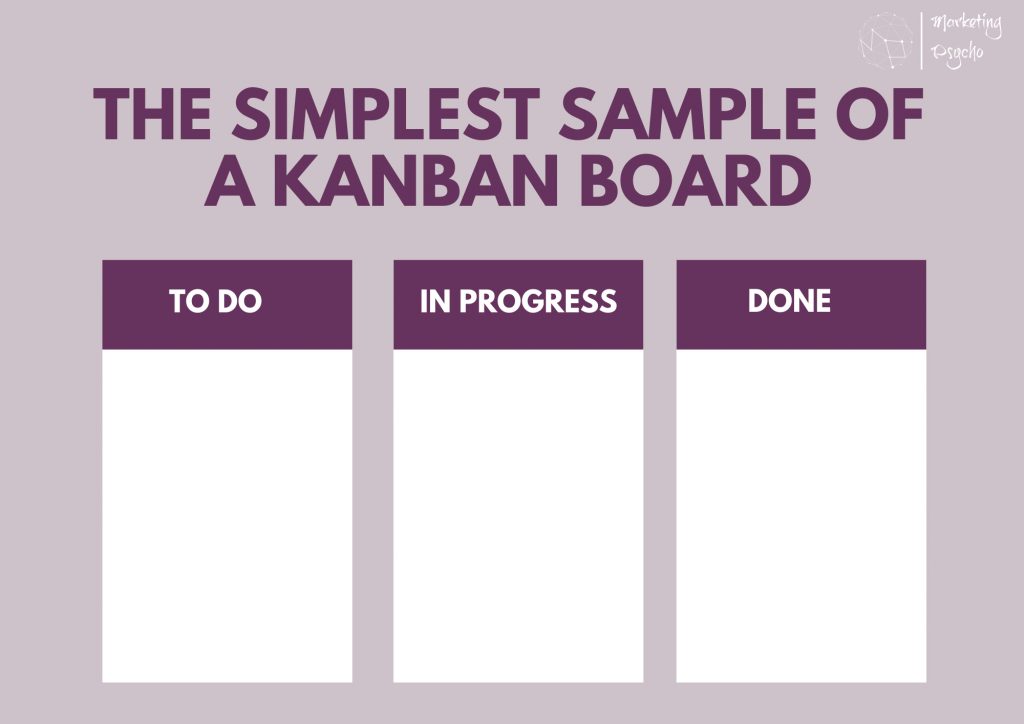
Scott Brinker recommends that at the very beginning of your path to agile technologies, use this simple version of the Kanban board so that your team can practice. Then you can start improving the columns, it also depends on the specifics of your company. The advantage of agile methods is that they offer you a vector of development with certain tools, and you already choose, depending on your goals and interests, how to adapt them. For example, the author suggests the following option for improving the board. The In Progress column can be divided into more specific stages: Create, Review, Test. In this case, you will get a five-step Kanban board.
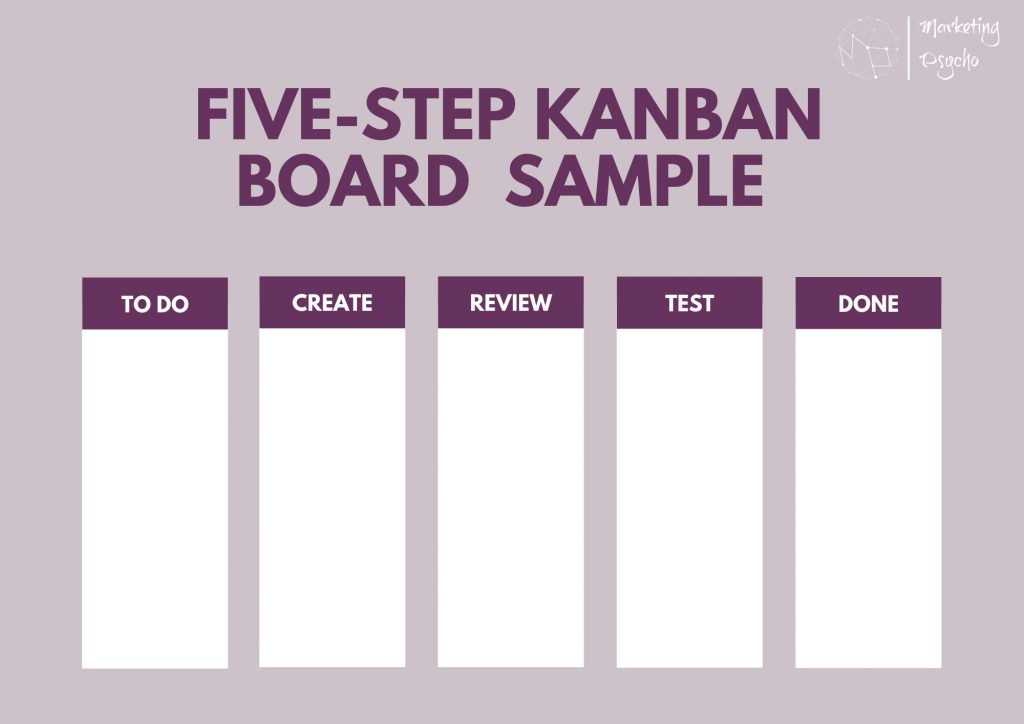
The tasks taken from the backlog for the current sprint are ordered by priority in the To Do column. When team members start working on tasks, they put them into the Create column. When the creation stage is completed, the tasks go to the Review stage, where they are either rechecked by a peer or considered by the manager for approval. Once the task has passed the Review, it can proceed to the Test stage. The Test column may not apply to all tasks. The test can be performed in various ways: A/B-test that compares two or more options; a sequential champion/challenger test comparing the results of a new effort with its predecessor, or it can be a stand-alone test- try something new and see what the result will be. The only requirement is that there are consistent metrics or indicators by which success will be measured. The task is then moved to the Done column, where it is ready for discussion at the next sprint review. Tasks that do not make sense to test can go directly from consideration to execution.
Each column on the Kanban board should have a limit on the maximum number of tasks that can be performed at this stage at the same time. This is called a limit work in progress, often abbreviated WIP. If the column is full, then you can no longer add tasks to it until there is space for an existing job that will be deleted. This prevents the uncontrolled accumulation of unfinished work and many of the problems that result from this.
In addition to the columns, you can divide the board into several rows, such rows are sometimes called swimlanes. You can use the lines to track tasks related to various product groups, marketing channels, or strategic goals. You can also create places on your board where tasks are outside of the main workflow. Scott Brinker gives the following options as an example: a Triage box, a Bumped bin, a Killed bin.
Whichever option you choose, the main thing is that it meets your goals and helps you in your work, otherwise, instead of a positive result, you can get an overloaded and confusing workflow.
You can use Kanban boards not only in personal meetings but also in digital form, there is a wide range of software for this. Of course, in an agile methodology, live communication is preferred, during which new ideas are born and there is an opportunity to respond immediately, but in the modern world, with the development of digital technologies and with a geographical gap, the use of the electronic version is very much in demand.
Scrumban is the third type of agile methodology mentioned in this book. This type was developed by Corey Ladas and is a combination of Scrum and Kanban methodologies.
So, the next aspect for successful agile marketing management, according to Scott Brinker – is INNOVATION.
People are always interested in something fresh, when a new marketing tool appears, the response of consumers is usually high because at the very beginning they feel interested, they want to learn and try, but then the sense of novelty disappears, and the indicators fall. This is a natural process, so creating innovations is very important.
Scott Brinker also draws a parallel between IT and marketing in creating innovations as well as in using agility. Here he talks about the MVP concept. MVP is a minimum viable product, which is used in software development and means a simple implementation of a product that, according to the company, will find a response from its target audience. The “minimum” means investing the least amount of time, money, and effort necessary to try something before it becomes clear whether the product idea will be attractive to people.
But the MVP must also be viable. It can’t be cut down so much that it doesn’t give something really valuable. The key advantage of MVP is that it allows you to quickly try out more ideas and options with limited resources. That is why the MVP concept is considered lean. The author applied this concept to agile marketing and called it “Minimum Viable Promotion” since the scope of marketing is much broader than the product. Any touchpoint with the client (landing page, email, blog post, etc.) can be built as an MVP experiment.
But to make it meaningful, the author suggests answering the following four questions:
- What marketing hypothesis does this MVP test?
- What metric(s) will serve as evidence of its success?
- What value does this MVP offer its audience?
- Does the quality of the MVP reflect our brand?
You need to test your ideas to understand what works and what doesn’t.
Scott Brinker suggests using the 5 Whys method, which is also used by software developers, to find new ideas. When something went wrong as you planned, you need to find out the reason for this deviation. To find the root cause of this problem, you need to ask “Why?” And then ask “Why?” again to the received response. And this should be done five times, it is considered that this is enough to understand what happened. This method, originally developed by Sakichi Toyoda, the founder of Toyota, is designed to go beyond the superficial symptoms and identify deeper root causes.
The author gives the following situation as an example:
- Why didn’t our landing page convert more visitors? Because people didn’t take our call-to-action offer.
- Why wouldn’t they have taken it? Either our offer wasn’t attractive enough, or we were asking for too much with the call to action.
- Why wouldn’t the offer have been attractive if they intentionally clicked through to that landing page? Maybe where they clicked from led them to expect something else.
- Why would they have expected something else? The ad or e-mail they clicked to get there may have had a mismatched message or, in context, implied something very different.
- Why would that have happened? Our search advertising and e-mail marketing efforts are disconnected from landing page optimization on our website.
After finding out the root cause, you can study organizational or technological changes to fix this problem.
SCALABILITY is the third element of agile marketing management described in this book. Once you have come up with an idea, it’s time for its wide application or for scaling. But it is necessary to understand that innovation and scaling are two principles that are opposite to each other, since innovation is experimentation, and scalability is standardization. But for the successful functioning of the business, it is necessary to find a balance between them.
Here Scott Brinker talks about Maturity Models, as well as about Pace Layers. Maturity models define a structured set of stages or levels that an organization usually goes through in the development of certain abilities or competencies. All levels develop and adapt at different speeds. One of the first maturity models was the Capability Maturity Model (CMM), created by the Software Engineering Institute at Carnegie Mellon University.
In a typical five-level company model, the levels look like this:
- Novice: There is no formal structure or process.
- Practitioner: This is where the preliminary structure appears. Some repetitive processes are used.
- Intermediate: Structure is well defined. The processes and standards are documented. Performance is increasingly consistent.
- Advanced: Processes are measured quantitatively by certain indicators. Best practices are being widely implemented. The performance is highly consistent.
- Expert: Performance is consistently the best-in-class. A detailed analysis of the causes and effects. Processes are constantly being optimized. Leading-edge developments are regularly incorporated.
The fifth level is usually an ideal state to strive for, but it is practically unattainable.
With the emergence of new disciplines in marketing, such as content marketing, web analytics, social media marketing, etc., the corresponding maturity models have also appeared and spread. Which model to choose, you should determine based on your goals, you can also use several types to create your own. The main thing about maturity models is that with the help of their use, the company can systematically think through the development of its capabilities.
In modern agile marketing, interconnection plays an important role, if you change one element, it will definitely affect the others.
For example, if the links that you have inserted into your e-mail newsletter do not work correctly, then customers will not be able to click on them or will go to the wrong pages. This will lead to the fact that your advertising campaign will be evaluated with errors, since the indicators will not be tracked, and will also create a misunderstanding among your target audience.
The goal of scalability is to organize the various components of the solution to reduce negative consequences. Scott Brinker also turns to the field of software here. He talks about a way to divide the various components of agile marketing into groups by using the speed of their change.
The Seven Pace Layers of Modern Marketing
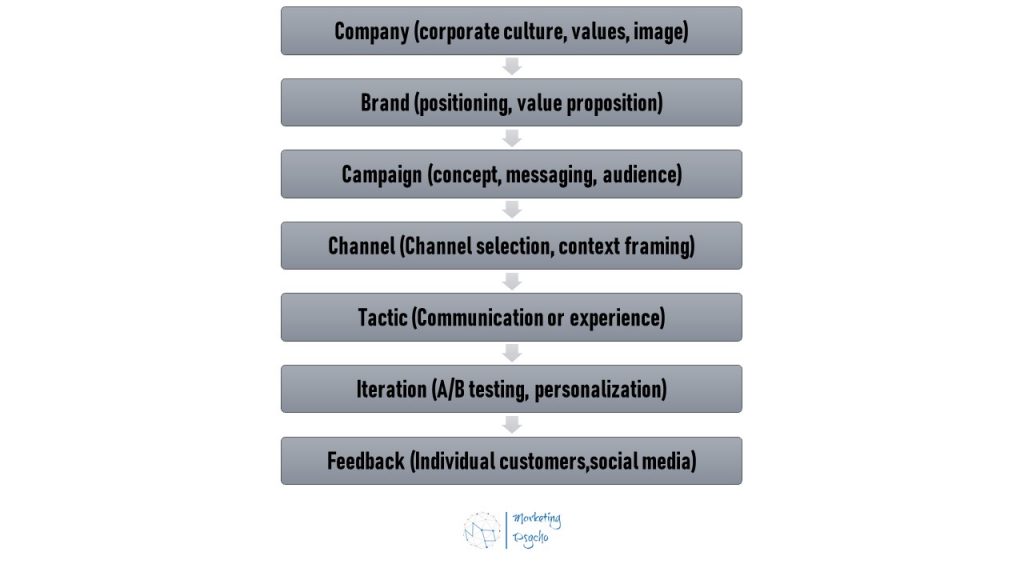
- Company. This level corresponds to how your company is perceived by both internal employees and the external market based on your corporate culture, values, and image. Speed of changes: this is the most difficult stage to change, a long period of time is needed.
- Brand. This level deals with the positioning and value proposition of the company’s products and services, each of which can be its own brand. Speed of changes: quarters and even years.
- Campaign. This level forms a creative bridge between a high-level strategy and the tactical implementation of touchpoint with customers. Speed of changes: months.
- Channel. This level is responsible for creating the context within the campaigns. It helps to understand how the campaign can best meet the needs of the audience in the conditions of each specific channel and coordinates the interactions between the channels. Speed of changes: from a week to a month.
- Tactic. At this level, the design and development of specific communications or experiences within the brand, campaign, and channel takes place. Speed of changes: from a few days to several weeks.
- Iteration. Iterations can A/B test alternative versions and use personalization to quickly replace content and services for different customers. Speed of changes: within a few days or maybe even hours.
- Feedback. An ultra-fast moving layer of feedback from customers that marketers can interact with. Speed of changes: hours or minutes.
The division into levels is quite conditional, many tasks are not included here and are located between levels, also the structure may differ in different companies. Nevertheless, it can help to understand the problems that arise when these interconnected elements move at different speeds. The levels themselves provide hierarchy and management. They set boundaries and standards to help achieve unity in what is built on top of them.
And the last element of agile marketing management is TALENT. In the digital world, people are the most important factor for marketing success. The search, development, and education of outstanding talents is the main source of competitive advantages in modern marketing. At the heart of agile marketing is giving individual marketers and small marketing teams more responsibility for their work and considerable freedom in how they achieve their goals. They work on trust and transparency, not on command and control. This gives marketers at all levels an idea of how their parts fit into the strategy of the whole. And this allows them to contribute to its evolution. Every marketer is encouraged to experiment, repeat and learn. Everyone invents something new. Everyone is learning. Everyone is growing.
Scott Brinker in his book Hacking Marketing: Agile Practices to Make Marketing Smarter, Faster, and More Innovative drew an interesting parallel between the field of IT technologies and agile marketing. At first glance, these are completely different disciplines, but after reading the book, you can see that this is not the case, these two areas have a lot in common thanks to the digital world. Many of the methods used by software developers have organically fit into the world of marketing. Adapt them to your goals and it will certainly benefit you.
You can read more marketing, management and sales Book Reviews in the special section of the website. And you can make your marketing more agile with these 3 Great Apps to Keep Your Marketing Team Running.


